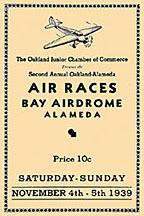
|
          about activities, operations, and people at SFBA is needed, as well as photos. Explanatory email first to SFBA. |
|
It was a true field of dreams, an oasis sitting uncomfortably next to a busy avenue, its sweet sounds of aircraft engines occasionally challenging the rumble of passing trucks. It was a classic place, even its name had a stately ring to it — San Francisco Bay Airdrome. Not airport nor airfield, mind you, Airdrome. And not in San Francisco, but Alameda on San Francisco Bay. San Francisco Bay Airdrome, Alameda: (Commercial Public) 2 mi NW of town, 1.5 mi S of Oakland; elev 10; 3800' x 2500' sandy silt field with crushed shell rwys W 3400', N 1700' and rolled dirt rwys NE 3600', N 2500'. Goodyear blimp anchorage SW. (data 1936) In 1920, as part of an inheritance from a wealthy alumnus, the University of California received 458 acres of partially filled marshland on both sides of Webster Street. In 1929, capitalizing on the airplane fever created by Lindbergh's transcontinental flight, UC Regents began construction of an airport. The marsh was drained by a network of ditches from which water was pumped. After grading the site, crushed oyster shells were barged from Bay Farm Island to pave a 3,400' and 1,700' runway, and the airdrome's business was housed in a single 53,000-square-foot hangar, constructed for $150,000.  That it was in the wrong place at the right time would not be known for ten years, for when the Bay Airdrome had its gala christening party on Saturday, August 16, 1930, it was there because it was needed. And, because it was needed, it became a busy place, an early home base for Coastal Air Freight, Varney Air Lines, West Coast Air Transport, Western Air Express, the transbay Air Ferries, and Boeing's Pacific Air Transport. Its success during 1930-31 led to a 160' addition to the original hangar and the first 160' of another one. Three more hangars were soon added, actually attached to the first, then a fifth one, separate and canted at an outward angle to accommodate a planned, but unbuilt, runway.   Aerial extravaganzas in 1938 and 1939, attracting tens of thousands of locals to their airfield, failed to blank the tympani of doom that persisted as tentacles of commercial and urban development began probing the area. By the end of 1940, everyone knew it was inevitable.
Aerial extravaganzas in 1938 and 1939, attracting tens of thousands of locals to their airfield, failed to blank the tympani of doom that persisted as tentacles of commercial and urban development began probing the area. By the end of 1940, everyone knew it was inevitable.When in 1941 it was decided that Bay Airdrome's traffic interfered with operations at the new NAS Alameda, it was shut down. The Navy first condemned 70 acres bordering Atlantic Avenue for a housing project, then ordered the abandonment of "America's first downtown Airport". Without so little as a deserved fanfare, it quietly slid off the map and into memory of those who made it live. Another field of dreams was gone. (— K O Eckland) |
